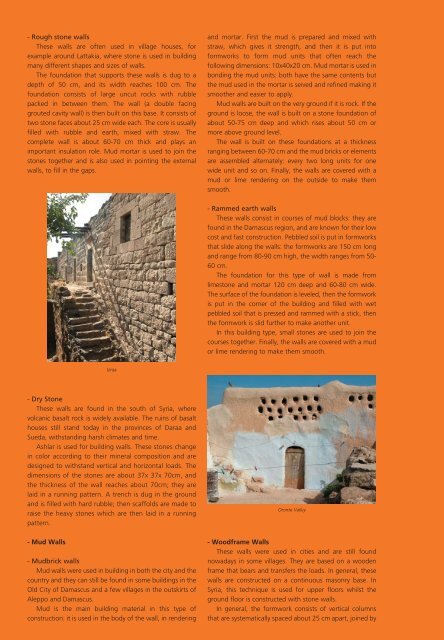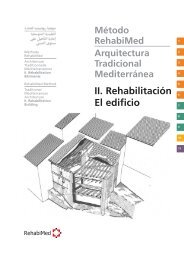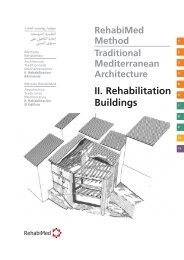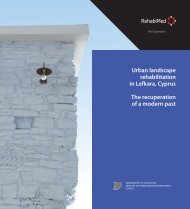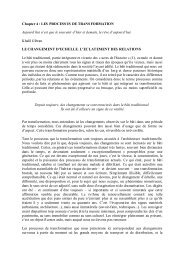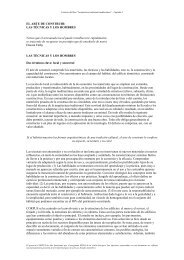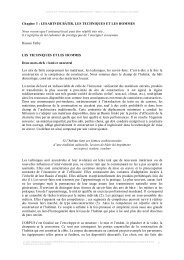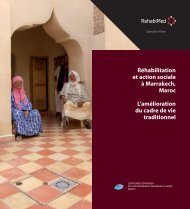Traditional Syrian Architecture
Traditional Syrian Architecture
Traditional Syrian Architecture
Create successful ePaper yourself
Turn your PDF publications into a flip-book with our unique Google optimized e-Paper software.
The Building Arts<br />
- Rough stone walls<br />
These walls are often used in village houses, for<br />
example around Lattakia, where stone is used in building<br />
many different shapes and sizes of walls.<br />
The foundation that supports these walls is dug to a<br />
depth of 50 cm, and its width reaches 100 cm. The<br />
foundation consists of large uncut rocks with rubble<br />
packed in between them. The wall (a double facing<br />
grouted cavity wall) is then built on this base. It consists of<br />
two stone faces about 25 cm wide each. The core is usually<br />
filled with rubble and earth, mixed with straw. The<br />
complete wall is about 60-70 cm thick and plays an<br />
important insulation role. Mud mortar is used to join the<br />
stones together and is also used in pointing the external<br />
walls, to fill in the gaps.<br />
and mortar. First the mud is prepared and mixed with<br />
straw, which gives it strength, and then it is put into<br />
formworks to form mud units that often reach the<br />
following dimensions: 10x40x20 cm. Mud mortar is used in<br />
bonding the mud units: both have the same contents but<br />
the mud used in the mortar is seived and refined making it<br />
smoother and easier to apply.<br />
Mud walls are built on the very ground if it is rock. If the<br />
ground is loose, the wall is built on a stone foundation of<br />
about 50-75 cm deep and which rises about 50 cm or<br />
more above ground level.<br />
The wall is built on these foundations at a thickness<br />
ranging between 60-70 cm and the mud bricks or elements<br />
are assembled alternately: every two long units for one<br />
wide unit and so on. Finally, the walls are covered with a<br />
mud or lime rendering on the outside to make them<br />
smooth.<br />
- Rammed earth walls<br />
These walls consist in courses of mud blocks: they are<br />
found in the Damascus region, and are known for their low<br />
cost and fast construction. Pebbled soil is put in formworks<br />
that slide along the walls: the formworks are 150 cm long<br />
and range from 80-90 cm high, the width ranges from 50-<br />
60 cm.<br />
The foundation for this type of wall is made from<br />
limestone and mortar 120 cm deep and 60-80 cm wide.<br />
The surface of the foundation is leveled, then the formwork<br />
is put in the corner of the building and filled with wet<br />
pebbled soil that is pressed and rammed with a stick, then<br />
the formwork is slid further to make another unit.<br />
In this building type, small stones are used to join the<br />
courses together. Finally, the walls are covered with a mud<br />
or lime rendering to make them smooth.<br />
Izraa<br />
- Dry Stone<br />
These walls are found in the south of Syria, where<br />
volcanic basalt rock is widely available. The ruins of basalt<br />
houses still stand today in the provinces of Daraa and<br />
Sueda, withstanding harsh climates and time.<br />
Ashlar is used for building walls. These stones change<br />
in color according to their mineral composition and are<br />
designed to withstand vertical and horizontal loads. The<br />
dimensions of the stones are about 37x 37x 70cm, and<br />
the thickness of the wall reaches about 70cm; they are<br />
laid in a running pattern. A trench is dug in the ground<br />
and is filled with hard rubble; then scaffolds are made to<br />
raise the heavy stones which are then laid in a running<br />
pattern.<br />
Oronte Valley<br />
- Mud Walls<br />
- Mudbrick walls<br />
Mud walls were used in building in both the city and the<br />
country and they can still be found in some buildings in the<br />
Old City of Damascus and a few villages in the outskirts of<br />
Aleppo and Damascus.<br />
Mud is the main building material in this type of<br />
construction: it is used in the body of the wall, in rendering<br />
- Woodframe Walls<br />
These walls were used in cities and are still found<br />
nowadays in some villages. They are based on a wooden<br />
frame that bears and transfers the loads. In general, these<br />
walls are constructed on a continuous masonry base. In<br />
Syria, this technique is used for upper floors whilst the<br />
ground floor is constructed with stone walls.<br />
In general, the formwork consists of vertical columns<br />
that are systematically spaced about 25 cm apart, joined by<br />
20


